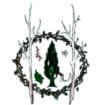In 2004, two of our members donated the construction of a large pavilion in our sanctuary space to be used to house CedarLight folks during inclement weather. They named the pavilion “Dun Elphame” and donated a statue to the Queen of the Elphame in its honor. Some information on Dun Elphame is below:
Queen of Elphame
 Elphame is the Goddess of the Underworld and Keeper of the Dark Mists. Elphame is responsible for the creation of both the banshee and the imp. She is the goddess of the mists which encapsulate our realm and the Underworld. Elphame is the judge of the dead, and oftentimes the living.
Elphame is the Goddess of the Underworld and Keeper of the Dark Mists. Elphame is responsible for the creation of both the banshee and the imp. She is the goddess of the mists which encapsulate our realm and the Underworld. Elphame is the judge of the dead, and oftentimes the living.
She is the Goddess of the Under or Otherworld and disease who is often equated with the Greek crone goddess Hecate. As the crone image began to deteriorate in Europe with the coming of the Church, she became the goddess of “the witches” and of evil. In the past few hundred years, the Queen of Elphame has been seen as a Scottish Faerie Queen associated with Beltaine. Call upon her as May Queen and for aid in faery contact.
Queen of Elphame aka The Queen of the Faeries. Goddess of death, Disease, and Rebirth; hates bells; Rituals: Crone Goddess, banishing, death, destruction, battle, the Underworld Beltaine, rebirth. Scared to Queen of Elphame: moon, silver, primrose, pentagon.
“Elphame” literally means “elf-home,” or the faery realm. As it appears in The Witches Creed, Elphame is likely a syncratic reference to concepts surrounding life-after-death. In the Celtic pantheon specifically, the Queen of Elphame was the Goddess of Death and Rebirth, which also makes Elphame a likely reference to reincarnation.
There is also a literary Queen of Elphame. In English and Scottish Ballads, Elphame is mentioned as the high priestess of a Scottish witch cult, whose “gude-man,” or lover, Thomas of Erceldoune had become for seven years. Otherwise known as Thomas the Rimer (Rhymer), Thomas was both a poet and prophet famous during the Thirtheeth Century. In addition to immortalizing Elphame and her fair lands through verse, Thomas also cited his faery queen as his chief source of power and inspiration.
(Scottish) Also Elphlane and Elphane, which some claim is a corruption of the word “elfland.” She is a goddess of death, disease, and rebirth who is often equated with the famous crone goddess Hecate. As the crone image began to deteriorate in Europe with the coming of Christianity, she became a goddess of “witches” and of evil. In Robert Graves’s classic book, The White Goddess, he tells of sixteenth century Scottish witchcraft trials in which accusations of having “dealings” with the Queen of Elphame brought the death sentence.
In the past few hundred years, the Queen of Elphame has been seen as a Scottish faery queen and associated with Beltaine. Thomas the Rhymer always maintained that she appeared to him on a May Eve all dressed in diaphanous green silks and riding a white horse with nine silver bells tied into its mane (an odd association since Celtic faeries have always been thought to shun the ringing of bells).

